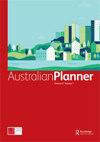Transitioning towards a circular economy solar energy system in Northern Australia: insights from a multi-level perspective
IF 1.5
Q2 Social Sciences
引用次数: 1
Abstract
ABSTRACT Increasing resource efficiency and decreasing waste by 2030 through prevention, reduction, recycling and reuse is one of the 17 United Nations Sustainable Development Goals. Australia is predicted to have up to 145,000 t of solar panel waste by 2030 and many large-scale solar systems are proposed to be built across Northern Australia. Research suggests that solar panel consumption and waste patterns are not dissimilar to other forms of e-waste such as mobile phones. Consequently, there is a need to rethink how the end of life of solar panels is managed. In this paper we raise the question of how Northern Australia should plan for managing solar panel waste arising from these huge installations in the future. This paper draws on the multi-level perspective, as a framework for conceptualising the transition challenges associated with promoting a circular solar energy system in the region. Adopting this approach facilitates consideration of social, technical and political drivers of solar panel waste and their implications for governance and planning in regional Australia. It is suggested that planning activities aimed at strategic, tactical and operational levels can help Northern Australia transition into a sustainable regional future. Practitioner pointers Need to develop planning system/framework/process for waste arising from solar farms. Usefulness of the multi-level perspective for identifying the range of stakeholders, barriers and drivers. Rethinking regional development of Northern Australia through a new industry space between the solar and waste sectors.北澳大利亚向循环经济太阳能系统过渡:从多层次角度的见解
通过预防、减少、回收和再利用,到2030年提高资源效率,减少浪费是联合国17个可持续发展目标之一。预计到2030年,澳大利亚将有多达14.5万吨的太阳能电池板废物,许多大型太阳能系统计划在澳大利亚北部建造。研究表明,太阳能电池板的消耗和浪费模式与手机等其他形式的电子垃圾没有什么不同。因此,有必要重新思考如何管理太阳能电池板的使用寿命。在本文中,我们提出了一个问题,即澳大利亚北部应该如何规划管理未来这些大型装置产生的太阳能电池板废物。本文借鉴了多层次的观点,作为一个框架,概念化与促进该地区循环太阳能系统相关的过渡挑战。采用这种方法有助于考虑太阳能电池板浪费的社会、技术和政治驱动因素及其对澳大利亚地区治理和规划的影响。建议在战略、战术和操作层面规划活动,可以帮助北澳大利亚过渡到可持续的区域未来。需要为太阳能发电场产生的废物制定规划系统/框架/流程。多层次视角对识别利益相关者、障碍和驱动因素范围的有用性。通过太阳能和废物部门之间的新产业空间,重新思考澳大利亚北部的区域发展。
本文章由计算机程序翻译,如有差异,请以英文原文为准。
求助全文
约1分钟内获得全文
求助全文

 求助内容:
求助内容: 应助结果提醒方式:
应助结果提醒方式:


